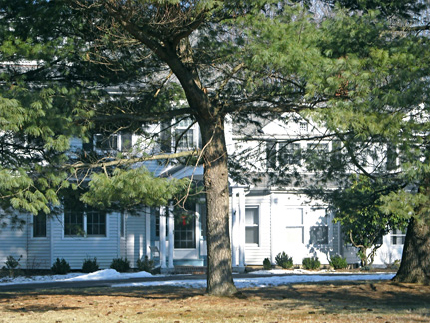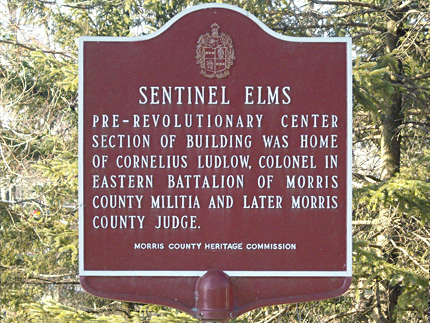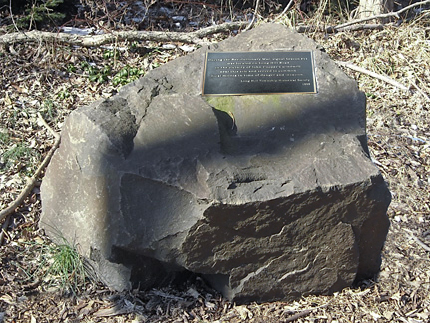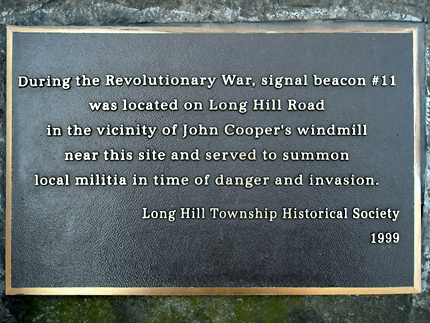



Sentinel Elms
Long Hill Rd. and Pleasant Plains Rd.
Map / Directions to Long Hill Township Revolutionary War Sites
This house is now the Trinity House
Sentinel Elms is now used by the Shrine of St. Joseph as part of the Trinity House. It is not open as a historic site.
The oldest section of this building is the center section, which was the home of Revolutionary War officer Cornelius Ludlow. Ludlow served as a Major and then a Lieutenant Colonel in the Eastern Battalion of the Morris County militia before resigning due to disability on November 13, 1777. [1]
Cornelius Ludlow died on April 27, 1812, at age 83. He is buried five miles west of Sentinel Elms in the Presbyterian Church Cemetery in New Providence. [2]



Signal Beacon Boulder Monument
Long Hill Rd. and Pleasant Plains Rd.
Map / Directions to Long Hill Township Revolutionary War Sites
This boulder monument, which is located across Pleasant Plains Road, marks the site of a signal beacon which was used to alert local militiamen during the Revolutionary War. It was most likely built here in late 1777 or early 1778. Around the same time, several other signal beacons were placed in locations throughout Central Jersey along the Watchung Mountains at Morristown, Bound Brook, and Summit. [3]
In 1779, General George Washington ordered that a series of additional signal beacons be created in New Jersey. Washington specified in his orders that the beacons were to be "built of Logs in the form of a Pyramid, 16 or 18 feet square at the Base, and about 20 feet in height, the inner part to be filled with Brush." [4] The brush would be set on fire and the blaze of the fire would make the beacon visible for a great distance when lit.
It is likely that the signal beacon which stood here had been built in a similar manner to those later described by Washington, or that it was redesigned in 1779 to match Washington's specification.

1. ^ Information drawn from:
• Morris County Heritage Commission sign in front of the building.
• Arthur E. Cooper "Col. Cornelius Ludlow," in Proceedings of the New Jersey Historical Society, Third Series, Volume 3 (Paterson NJ; Press Printing and Publishing Company 1906) Pages 42-44
Available to be read at Google Books here.• William S. Stryker, Official Register of the Officers and Men of New Jersey in the Revolutionary War (Trenton: Wm. T. Nicholson & Co., 1872) Pages 360
Available to be read at Google Books here2. ^ Ludlow's original gravestone is no longer standing. A modern gravestone has been placed at his grave in the Presbyterian Church in New Providence. There is a picture of the modern gravestone on the New Providence page of this website.
The modern gravestone simply gives the year of his death.
Arthur E. Cooper's article, "Col. Cornelius Ludlow" (See source note 1 above), gives the inscription on the original gravestone as "Col. Cornelius Ludlow died April 27th 1812 aged 83 years." The original gravestone was apparently still standing at the time his article was published.3. ^ A New Jersey Gazette article of January 28, 1778 described the creation of a beacon at Morristown and mentions that "buildings of similar construction are also erected at Long Hill and on the heights of Bound Brook."
The article is reprinted in:
Andrew M. Sherman, Historic Morristown, New Jersey: The Story of Its First Century (Morristown: Howard Publishing Company, 1905) Pages 266-267
Available to be read at Google Books hereMinutes of the Council of Safety of the State of New Jersey (Jersey City: John H. Lyon, 1872) Page 162
Available to be read at the Internet Archive here
▸ The minutes for Monday, November 17, 1777, reference plans "to erect a pile on the Hill near where Mr McGee formerly lived."
This pile is identified as being the signal beacon in Summit in:
Thomas Fleming, The Forgotten Victory (New York: Reader's Digest Press, distributed by E. P. Dutton & Co., Inc, 1973) Page 102 and its accompanying source note on page 3114. ^ “From George Washington to Brigadier General Henry Knox, 23 March 1779,” Founders Online, National Archives, last modified July 12, 2016, http://founders.archives.gov/documents/Washington/03-19-02-0562. [Original source: The Papers of George Washington, Revolutionary War Series, vol. 19, 15 January–7 April 1779, ed. Philander D. Chase and William M. Ferraro. Charlottesville: University of Virginia Press, 2009, p. 577.]
General Washington wrote three other letters the same day to other generals regarding construction of signal beacons:
• “From George Washington to Brigadier General William Smallwood, 23 March 1779,” Founders Online, National Archives, last modified July 12, 2016, http://founders.archives.gov/documents/Washington/03-19-02-0566. [Original source: The Papers of George Washington, Revolutionary War Series, vol. 19, 15 January–7 April 1779, ed. Philander D. Chase and William M. Ferraro. Charlottesville: University of Virginia Press, 2009, pp. 580–581.]
• “From George Washington to Major General Arthur St. Clair, 23 March 1779,” Founders Online, National Archives, last modified July 12, 2016, http://founders.archives.gov/documents/Washington/03-19-02-0565. [Original source: The Papers of George Washington, Revolutionary War Series, vol. 19, 15 January–7 April 1779, ed. Philander D. Chase and William M. Ferraro. Charlottesville: University of Virginia Press, 2009, p. 580.]
• “From George Washington to Major General Stirling, 23 March 1779,” Founders Online, National Archives, last modified July 12, 2016, http://founders.archives.gov/documents/Washington/03-19-02-0567. [Original source: The Papers of George Washington, Revolutionary War Series, vol. 19, 15 January–7 April 1779, ed. Philander D. Chase and William M. Ferraro. Charlottesville: University of Virginia Press, 2009, p. 581.]